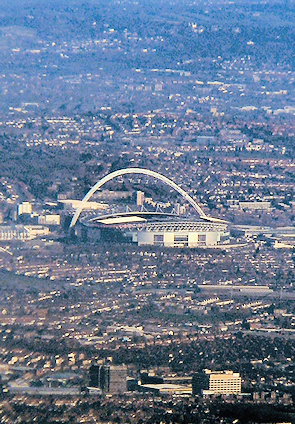Wembley
Wembley, Brent
A 20th-century commercial and residential creation with a significant Indian community, situated nine miles north-west of central London

This place was recorded as Wembalea – ‘Wemba’s clearing’ – in a charter of 825. Although Wembley was called a ‘township’ in 1212, the medieval settlement seems never to have grown very large.
The hamlet was assessed as one of the wealthiest in Harrow in the mid-16th century but this was probably because its chief landowners, particularly the Page family, also owned property elsewhere. Much of Wembley was common land, which the Pages led the way in enclosing from the early 17th century.
In 1805 the village had one inn, two mansions, three farmhouses and around 20 other houses. Wembley station opened in 1845 but six years later the population of Wembley and Tokyngton was still only 203.
It was not until the end of the 19th century that a sudden rush of activity erased the old village and created a residential and industrial suburb. The Wembley Hill estate was laid out from 1899 and Wembley Hill (now Wembley Stadium) station opened in 1906, stimulating housebuilding to its south.
The Wembley House and Wembley Dairy Farm estates followed soon afterwards and by 1920 a continuum of built-up streets linked the district with Alperton, to the south. The arrival of the Bakerloo line was meanwhile attracting factories and housing to North Wembley, while a garden suburb was laid out at Tokyngton.
In the mid-1920s the British Empire Exhibition was held at Wembley Park, endowing the borough with its most famous asset: Wembley Stadium – which has since been completely rebuilt.
The council built estates before and after the Second World War and – on the largest scale of all – at Chalkhill in the late 1960s. This was also a period of office construction along several main roads and the building of new shops in central Wembley. The arrival of Asian immigrants from India and east Africa began to transform the district at this time and Ealing Road is now one of the London’s four leading shopping areas for Asian goods, along with Southall, Tooting and Upton Park’s Green Street.
A satirical version of Wembley’s successful, well-educated Indian families appeared in the hit BBC television series The Kumars at No.42 (2001–2006).
